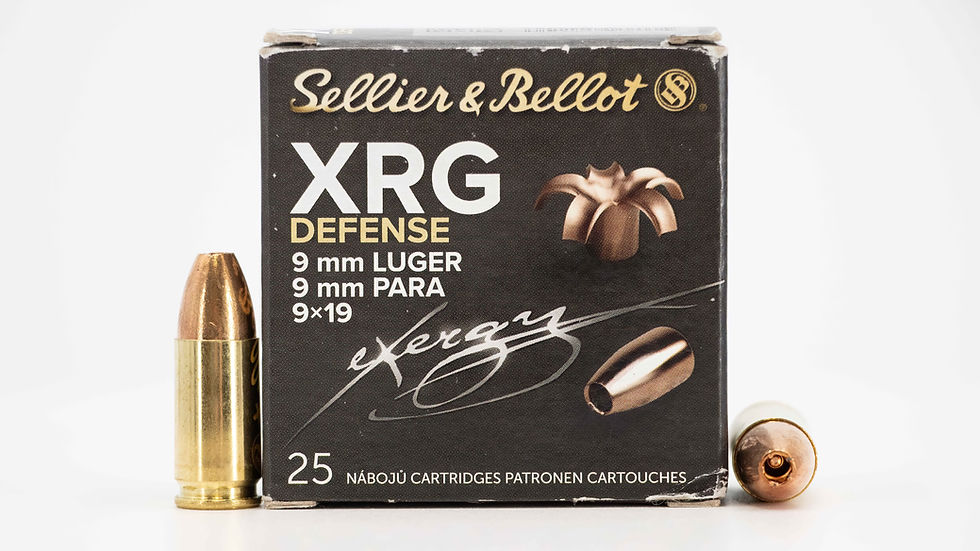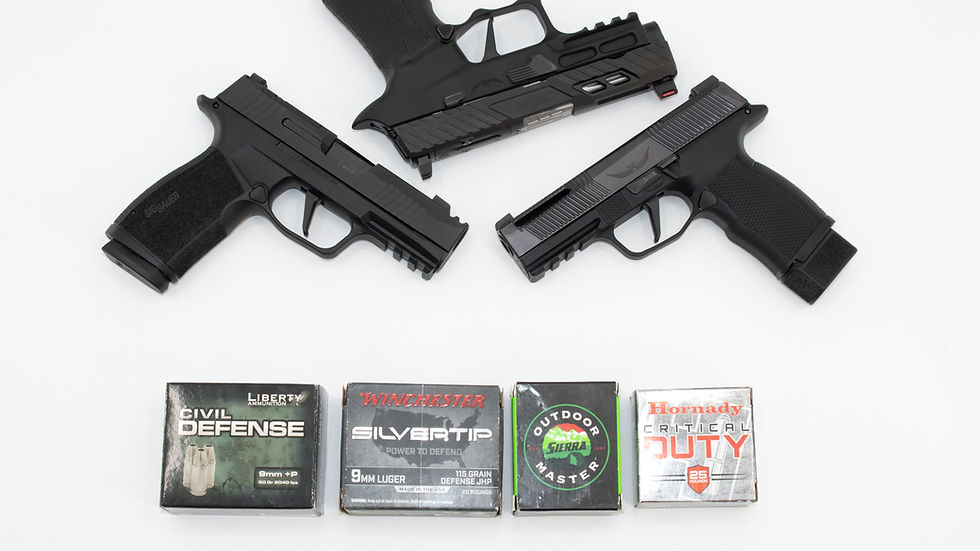Patron Special: Sellier & Bellot XRG 100gr 9mm
- Graham Baates

- Aug 21
- 5 min read
Updated: Aug 23
*Some of the external links found on this website are affiliate links. Those links use cookies to generate revenue and fund continuation of this website. By clicking an external link you are consenting to a temporary cookie, by purchasing from that link you are supporting this website. To opt out of cookies do not click external links.

This special coverage was made possible by a generous Patron who donated the ammunition for inclusion in reviews. If you value content like this free from industry dependency please consider joining the GBGuns Patreon. Despite years of What's For Dinner™ this load was new to me, and since the Patron was genrous enough to send a few boxes I decided to dive a little deeper into Sellier & Bellot's XRG 100gr 9mm load.
The XRG line of ammunition from Sellier & Bellot consists of solid copper hollow point (SCHP) projectiles, a concept I first encountered a decade ago but has since faded from popularity. The concept is that these one-piece projectiles are stronger and lighter than conventional bullets using a lead core.
Sellier & Bellot XRG 100gr 9mm Pricing as of 21AUG25
Click links for current pricing
Stronger: The problem with conventional cup-and-core bullets is that they tend to break apart without advanced construction techniques. A broken-off piece carries little energy with it and means a potential reduction in damage, change of bullet path, and reduction in wound cavity size. If a projectile remains in tact inside the target those chances are reduced.
Lighter: Projectile weight impacts both speed and recoil if pressure is constant. 9mm ammunition is kept at the safe pressure of 35,000psi in the US, this means a lighter projectile is likely to both be faster and have lower recoil than a heavier one. Velocity is the king when it comes to energy as demonstrated in the Liberty Ammunition Test where we saw a lighter and faster bullet delivering up to 69% more energy than one of standard weight and speed.
As I wrote that I couldn't help but remember all the times a less-educated shooter boasted, "I carry _____ 147gr" in a short pistol. As we proved in a previous study, heavy ammunition and short barrels are a sure way to hit with less energy than your caliber should be providing.

Energy: Why care so much about muzzle energy? Because we don't have a real way to test how a projectile will perform in a bad guy muzzle energy is the second best data we have assuming the projectile performs as intended. Gel tests give great visuals, but no matter how it's conducted there's always a way to argue that it's not realistic.
Taking the use of force back to the beginning mankind used fists and feet. The "projectile" is a fixed variable, but the damage done comes down to "shot" placement and how hard the hit was delivered. Advancing to projectiles the science remains the same and ft/lbs of energy is how we measure the amount of force behind that projectile.
To Test the Sellier & Bellot XRG I gathered three pistols to chronograph five shots from each.

The Grand Power K100 4.25" was meant to serve as a control as that's the pistol I used for the massive 9mm range ammunition guide. The barrel being slightly longer than what SAAMI set as a standard for 9mm gives us an opportunity to see if any extra velocity (and thereby energy) is gained with this particular load, or if the charge is optimized for shorter barrels.

The SAR 9C Gen 3 served as our basic 4" barrel to match SAAMI specifications as well as see how far off we'd be from the advertised velocity. Testing at the low altitude of around 300' means denser air and usually lower velocity than at higher altitude.

The Canik METE MC9 served as the en mode barrel length of 3.1" found on so many of todays micro compacts. My interest here was to see how much energy this particular load would lose from a shorter barrel. Aside from companies marketing "compact"-specific loads, I have yet to see an ammunition company warn against short barrels when selling what the consumer may depend on in a life-or-death scenario.
Rumble Link for when YouTube deletes video.
RESULTS
There were some interesting results. Some were expected, others not.

Velocity: It's common to not achieve advertised velocity; either the manufacturer uses a special barrel, or runs their tests at high elevation where the air is thinner. My test was done at an elevation of about 300'. What is interesting about these results is that the 4" SAR 9C Gen 3 acheived higher velocity than the 4.25" Grand Power K100. This could mean that the load is truly optimized for a 4" barrel and is already getting tired by the 4.25" mark, or that the ammunition is inconsistent and the 5 rounds I grabbed for the 4" gun were loaded hotter than the 5 rounds I grabbed for the 4.25" test (I also noted some inconsistencies in the projectiles in the video) . The only way to know for sure would be to test a lot more ammunition through several other guns. Typically between the longer barrel and the stepped chamber of the Grand Power we'd have expected higher velocity.

Percentage of Advertised Velocity is something I like to look at because hollow point projectiles have a velocity window in which they perform as intended. Too slow and the hollow point won't open, too fast and you run the risk of the projectile breaking apart. I have yet to see a manufacturer state what that window is, but if we assume the advertised velocity is ideal, the velocities acheived in this test seem to be reasonably close. I'd like to think that means the S&B XRG projectile would perform as intended from any of these three barrel lengths.

How hard does it hit? Going back to the entire point of firing a projectile; delivering energy on target. SCHPs lost popularity in the past due to their tendency to not penetrate as deeply as the FBI's standards. It was for that very reason that I carried SCHPs; I'd rather deliver all of the energy in the target than waste it passing through a target. Looking at the data gained we can average 360 ft/lbs of energy.
Assuming the projectiles perform as intended that means S&B XRG 100gr 9mm hits harder than the Sig V-Crowns previously tested and harder than the variety tested in a barrel-length study, but not as hard as Liberty Ammunition's +p Civil Defense loads.
Muzzle energy and perceived recoil do not always correlate, but if you've ever noticed a difference when shooting steel with one range load versus another you can compare these results with the massive chart at the end of my range ammo test article. It looks like Sellier & Bellot's XRG 100gr load hits about as hard as some of the best loads from that test series.
In Conclusion, without firing hundreds of rounds through dozens of guns into real targets, this perliminary look at the Sellier & Bellot XRG load suggests it's a good round, especially for the price. YouTube's Tools & Targets did a test of this ammunition about a year before this article and had great results, but also higher velocity. That velocity difference could be altitude or loading inconsistencies from lot to lot. Looking at the penetration and expansion in the Tools & Targets video this looks to be a great round.









Why YES, thank you, I DID find this educational! I have sought an inexpensive FAST copper solid 9mm hollowpoint for years, and here it is, nearly half as expensive as other premium lead core self-defense loads. I too have an obsession with avoiding over-penetration! I will look for it now.......................elsullo